The Firsts
Rookies or not, here they are
Jump to the cards The hobby sure has changed over the last few decades. Up until 1980, a player’s first card was a rookie card and there was usually only one card with that designation. Life was simple. When the Topps monopoly was broken in 1981, not only did that give us rookie cards from up to three different companies, but the addition of update sets as a regular feature complicated the rookie card landscape. The following years brought rookie cards from players who had yet to reach the majors or, most famously with Mark McGwire’s 1985 Topps rookie card, were still amateurs. More manufacturers and more products brought an explosion of rookie cards, though the occasional superstar (Pedro Martinez, Mike Piazza, Mariano Rivera, etc.) managed to get through their first year with retively few cards.
Everything changed again in 2006 when the MLB Players Association took control of the term Rookie Card. In an effort to bring the hobby’s focus back to the players on the field, the MLBPA set requirements for Rookie Cards that prohibited prospects from appearing in base sets. On its own, this would have greatly simplified the rookie card conundrum. Two factors however made things more complicated than ever. First, the MLBPA’s refusal to renew Playoff/Donruss’s license caused an imbalance between supply and demand that brought about the rise of unlicensed products focusing on prospects and retired players. They reversed course in 2011, issuing a license to Panini (the current owner of the Donruss brand) and, in 2013, issuing a license to Upper Deck, which had maintained its MLBPA license in 2006 but lost its MLB Properties license in 2010 when Topps was granted an exclusive MLB license. The exclusive MLB deal and a more permissive MLBPA has given us several products every year with current players, including Rookie Cards, but no team names or logos. It is an unfortunate situation, but this is the price of monopolies.
The second and more bizarre result of the 2006 changes is that prospects, while barred from base sets, are now more prevalent than ever in MLB-licensed products as well as unlicensed or MLBPA-licensed products. While base sets are off limits, prospects may appear freely in insert sets, even if the inserts are more numerous than the base set. 2014 Bowman, for example, featured a 220-card base set plus a 110-card prospect set, a 110-card chrome prospect insert set, a 100-card Top 100 Propsects insert set, and a 150-card mini prospect insert set. While the latter two are true insert sets, cards from both 110-card sets are about as common as cards from the 220-card base set. Not only do we now have “official” Rookie Cards, but we also have lots of not-rookie cards released along with them on top of all of the unlicensed prospect cards and licensed minor league cards.
And that brings us to the true conundrum – what makes a rookie card these days? Official Rookie Cards now often follow years of MLB-licensed cards that are practically indistinguishable from their RC logo-adorned equivalents. And while there are supposedly rules governing who is eligible for Rookie Cards and which cards are eligible for the RC logo, an analysis of Rookies and not-Rookies shows no clear pattern in what is or is not eligible beyond appearing in an MLB game. The known rules require appearing on a team’s 25-man roster, disqualifying September call-ups, but the MLBPA’s own lists of RC-eligible players are often full of September call-ups. Insert and subset cards, which were ineligible for the rookie card designation under the hobby’s pre-2006 rookie card rules, may or may not bear the RC logo under today’s seemingly arbitrary rules.
The irony of course is that, in defining the term “Rookie Card,” the MLBPA has removed nearly all meaning from that term. These days, a rookie card is whatever you want it to be. First professional card? First MLB-licensed card? First RC-logo card? Take your pick, it’s all up for grabs. Let’s throw in first cards for specific teams while we’re at it; if we can go pre-RC, why not go post-RC? And that’s just what we’ll capture here in The Firsts.
Which firsts will be covered? That depends. Some players have an RC-logo card as their first card, so that makes it easy. Others go through various levels of licensing, logos, and uniforms before getting to that point. For our purposes, we’ll start at professional cards (ignoring college and national team amateur cards) and stop when we have an RC-logo or later base card with the player in a Mets uniform (meaning MLB-licensed). Parallels and autographed variants may be shown in place of base cards if I don’t have an appropriate base version on hand, so just use your imagination if it comes to that.
Don Zimmer
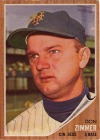 |
| First Mets Card |
We’ll start this off with a first of firsts, one of the first-ever Mets cards featuring the first player to ever wear a Mets uniform. Don Zimmer was drafted by the Mets with the fifth pick in the 1961 expansion draft, making him one of the first players in the organization. He also became one of the first Mets to be traded when he was sent to the Reds a month into the 1962 season. Unable to find a photograph of Zimmer in a Reds uniform, Topps released his 1962 card with a Mets uniform and Reds as the team name. Standard practice of the time was to use a photograph without a hat visible or overlay a different uniform, so this is typically considered an uncorrected error even though it seems to have been intentional. Thanks to this “error,” we have this first and only Don Zimmer Mets card.
Mike Piazza
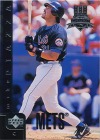 |
| First Mets Card |
This one seemed almost too good to be true. With extension talks for their star catcher getting messy in 1998, the Dodgers opted to deal Mike Piazza to the salary-dumping Marlins. Just over a week later, the Marlins flipped Piazza to the Mets for prospects. Piazza would sign a contract extension in New York and led the Mets to the postseason twice while becoming the all-time home run leader among catchers. A month after Piazza first suited up in Queens, Upper Deck released this variant of Piazza’s Dodgers base card (along with a Marlins version).
David Wright
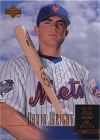 |
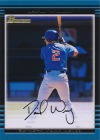 |
| First Mets Card (XRC) | First RC |
David Wright made his Mets debut on July 21, 2004 (10 years ago if you’re reading this on the day this piece was posted, otherwise never mind), but his cardboard debut goes back to 2001, just a few months after he was drafted as a compensation pick for the loss of Mike Hampton to the Denver school system. Like many of the cards featured here, Wright’s First gives us some insight into the changing shape of the baseball card industry. As the number of products released each year increased in the new millennium, the hobby was faced with more challenges than ever with regards to the classification of rookie cards. Some players had dozens, if not hundreds, of rookie cards, while others received only one or two in update sets much like those that brought about the XRC designation. Brian Cole, for example, had only three cards released in 2000, all in factory update sets, but these received the standard RC designation as XRC had fallen out of use in the late ’80s. But the XRC would soon return.
As it turned out, David Wright would play a part in the return of the XRC designation and ultimately the hobby’s loss of control over the term “rookie card” as well. Upper Deck made a name for itself for bringing innovation to the hobby, but this also meant that they were prone to pushing things just a bit too far. Years before they made a colossal blunder and lost the baseball component of their business entirely, they ruffled feathers with 2001 UD Prospect Premieres, an update to the 2001 Upper Deck base set consisting entirely of prospects. Without any MLB players, this product was not licensed by the MLB Players Association and therefore the cards are not considered true RCs. The product was licensed by MLB Properties though, resulting in the return of the XRC designation to distinguish these from the fully-licensed cards that would appear in the following year.
And that’s where David Wright got his start, right in the middle of a hobby controversy that would lead to the MLBPA eventually banning all prospects from base sets. Wright would have rookie cards released in six 2002 products starting with 2002 Bowman. When it comes to having a rookie card that may or may not actually be a rookie card, David Wright was ahead of his time.
Jenrry Mejia
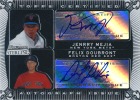 |
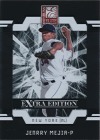 |
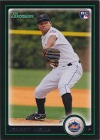 |
| First Pro Card | First Pro Base Card | First Rookie Card |
Jenrry Mejia’s career started going wrong as soon as he became the Mets’ top prospect. This led to both his first autographs in 2009 Bowman Sterling, 2009 Donruss Elite Extra Edition, and 2010 Topps Pro Debut Series 1. Of the three, only Donruss Elite Extra Edition included base cards of Mejia. That would be the extent of Mejia’s prospect cards as he was placed on the Mets 2010 Opening Day roster in a desperate attempt by the Mets GM and manager to keep their jobs amid a team meltdown. And so, Mejia would get plenty of Rookie Cards in 2010 starting with 2010 Bowman, starting a journey of highs and lows with a truly bizarre end.
Matt Harvey
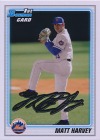 |
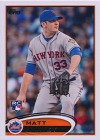 |
| First Pro Card | First Rookie Card |
Before the controversy, before Tommy John surgery, before the ESPN Body Issue, Matt Harvey was a guy at UNC with a really terrible mustache. Shortly after being drafted by the Mets 7th overall in 2010, his first professional card in 2010 Bowman Draft Picks & Prospects immortalized that particular bad college decision. Two years later, he was impressing at the major league level (sans mustache) and had his first Rookie Card in 2012 Topps Update. A late July debut meant that he was eligible for RCs too late to make it into most of the big rookie products, leaving him with just two Topps Rookie Cards (Update and Bowman Sterling).
Collin McHugh
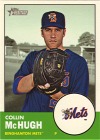 |
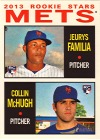 |
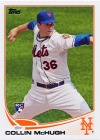 |
| First Pro Card | First Rookie Card | First Solo Rookie Card |
It isn’t often that a prospect makes his MLB debut with two wins at a major league stadium already under his belt, but Collin McHugh did just that when he debuted in 2012 following wins at Fenway Park with the Binghamton Mets in 2011 and the Buffalo Bisons in 2012. His first MLB win though wouldn’t come until 2014 with the Astros, his third club in less than 12 months. He didn’t have to wait that long for his first baseball card, which came in 2012 Topps Heritage Minor League Edition less than a month after his call-up. His first Rookie Card followed just a few months later in 2013 Topps Heritage alongside Jeurys Familia. Finally, Topps gave McHugh a Rookie Card of his own for his birthday in 2013 Topps Series 2. Sadly, this would be his last card as a Met, having been traded to the Rockies the night before.
Collin Cowgill
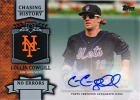 |
| First Mets Card |
Collin Cowgill, acquired in trade for minor league infielder Jefry Marte before the 2013 season, landed a starting role out of spring training and impressed early with an Opening Day grand slam. That would be it for Cowgill, who was designated for assignment the day before his first Mets card, this black jersey photoshop abomination celebrating a meaningless errorless streak and topped off with a sticker autograph, was released in 2013 Topps Series 2. Cowgill would never have a base card as a Met, instead receiving a second autograph card (plus gold parallel numbered to 10) in 2013 Topps Update commemorating his Opening Day grand slam (and shown in a proper Mets jersey). That makes just three total Mets cards for Cowgill, which must be a record in this age of endless parallels and variants.
Zack Wheeler
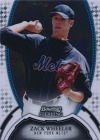 |
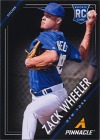 |
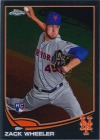 |
| First Mets Card | First Rookie Card | First MLB Rookie Card |
The first big score of the Sandy Alderson regime, Zack Wheeler changed coasts in 2011 and changed uniforms for the first time in 2011 Bowman Sterling. He would debut with the Mets two years later in June 2013. This is significant because the timing allowed him to have Rookie Cards in many products over the next six months, starting with Panini Pinnacle in August. Topps followed in September with Wheeler’s first MLB-licensed Rookie Cards in Topps Chrome, followed quickly by Rookie Cards in Bowman Chrome, Topps Finest, Topps Update, and Topps Triple Threads (and then several more…). That’s a huge crop of RCs compared to Matt Harvey, who debuted in July 2012 and had Rookie Cards in only two Topps products.
Travis d’Arnaud
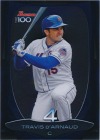 |
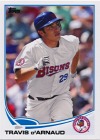 |
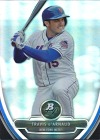 |
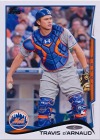 |
| First Mets Card | First Base Mets? Card | First Base Mets Card | First Rookie Card |
The big return from Toronto in the R.A. Dickey trade, Travis d’Arnaud came to the Mets in December of 2012. His first cards with his new club came in the form of inserts in 2013 Bowman, the Top Prospects card pictured and a Cream of the Crop mini refractor. His next appearance, in 2013 Topps Pro Debut, would be his most bizarre. By changing teams from the Blue Jays to the Mets shortly after the Buffalo Bisons changed their affiliation from the Mets to the Blue Jays, d’Arnaud managed to stay with the AAA Las Vegas 51s after the dust settled. Somehow, d’Arnaud was photoshopped into a Blue Jays Bisons jersey despite being identified as a member of the Mets organization on the back of the card. Is this his first base Mets card? It’s a minor league card showing him with a team that isn’t a Mets affiliate but is identified as one, so, um… In any case, his base 2013 Bowman Platinum card came just over a month later. An August debut pushed d’Arnaud’s first Rookie Cards back to 2014 with the first coming in 2014 Topps Series 1.
Rafael Montero
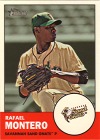 |
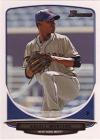 |
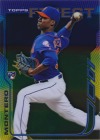 |
| First Pro Card | First MLB Card | First Rookie Card |
Once considered the Mets’ top pitching prospect after Zack Wheeler, Rafael Montero found himself pushed back a spot with the arrival of Noah Syndergaard into the system before the 2013 season. At the time, Montero had yet to receive an MLB-licensed card and only had a 2012 Topps Heritage Minor League Edition card in his portfolio. Montero’s next card would come in 2013 Bowman, which also featured the first inserts showing Syndergaard as a Met. Montero would make his MLB debut early in the 2014 season just a day before Jacob deGrom, but deGrom would ultimately outlast him and take over as the next big young Mets pitcher. Despite falling behind in other areas, Montero would come out on top in the race to be the first Mets starting pitcher after Wheeler with a Rookie Card. His Rookie Cards in 2014 Topps Finest and Topps Chrome may have come when his prospect status was falling, but they gave him something that Jacob deGrom was still strangely lacking. It’s almost like Topps doesn’t follow the sport during the season…
Jacob deGrom
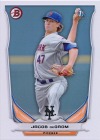 |
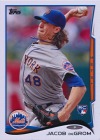 |
| First Pro Card | First Rookie Card |
Some prospects are hyped from the moment they first wear a professional jersey. Others have to demonstrate that they can dominate at the big league level before they get any respect. This year’s favorite for NL Rookie of the Year falls into the latter category. After converting from shortstop to pitcher in college, Jacob deGrom was drafted by the Mets in 2010. He lost all of 2011 to Tommy John surgery and then began a quick rise through the Mets farm system, impressing at every stop. By the end of the 2013 season, he was in the conversation for the 2014 Mets rotation along with Rafael Montero and Noah Syndergaard. All of this would finally get him the first baseball card of his professional career in late April’s 2014 Bowman.
When the Mets reshuffled their rotation in the middle of the May subway series, deGrom was the second fresh face to debut, just one day after Rafael Montero made his MLB debut. Montero would soon be on his way back to Las Vegas, but deGrom would spend the rest of the season (minus a brief DL stint) on the active MLB roster. His dominant performance in 22 games made him not only the top rookie starter in the NL but also the top starter on the Mets. With the season over and the RoY ballots cast, deGrom was missing just one small thing. A Rookie Card.
Under the current MLBPA rules, a player must appear on an active roster before being eligible for a Rookie Card. With a May debut and a minimum 2-month lead time to produce a card, the earliest a deGrom RC could have been expected was mid-July, square in the middle of prospect and oddball card season. His first real opportunity wouldn’t come until Topps Finest in August, but that RC honor went to Montero. Topps Chrome was next, but Montero got that spot too. Then Bowman Chrome came and went without a deGrom RC, leaving just Topps Update before the end-of-the-year products that rarely feature new Rookies. And that’s just where deGrom’s first Rookie Card appeared, following in the tradition of Matt Harvey in 2012 and Juan Lagares in 2013. As usual, Topps saved the best for last.
Andrew Brown
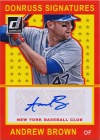 |
 |
| First Mets Card | First MLB Mets Card |
Andrew Brown spent most of the 2013 season as a bench player for the Mets and delivered replacement-level performance. So it wasn’t surprising that Topps passed him over for a card that year. What was surprising though was the 2014 Donruss checklist, which featured an Andrew Brown Mets autograph card. Was that a typo? It would be a nice little surprise if true. As it turned out, half of the Mets autographs on that checklist never materialized, but Brown’s wasn’t one of them. It might not have been the nicest-looking card, but it really did exist.
Brown started 2014 off with a bang, or more specifically a 3-run home run off Stephen Strasburg in the first inning on Opening Day. After that, not so much. He was sent down to AAA 3 weeks later, presumably to keep Cesar Puello from getting much of any playing time. His next trip to the big leagues would come in June, when he hit a home run in his first game back in the lineup. And then did nothing noteworthy over the next 10 days and was sent back to Vegas. Even though he was still on the 40-man roster, Brown would finish the year in Vegas and would not be called on to provide backup in the outfield in Queens. As it turned out though, his next appearance in a Mets uniform would be in 2014 Topps Update, where he would finally get a proper Mets card.
Michael Cuddyer
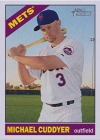 |
| First Mets Card |
The Mets struck quickly after concluding another losing season in 2014, signing Michael Cuddyer when the Rockies forced their hand by making Cuddyer a qualifying offer. The move cost the Mets their first round pick in the 2015 draft, giving them the smallest bonus pool of any team and a 52-spot wait before they get to make a pick. This was a clear signal that the Mets would be making deals and getting the players they need at any cost. And then they did nothing, leaving Cuddyer as the team’s only significant offseason acquisition. While the cost was a bit surprising, Cuddyer seemed destined to play for the Mets after David Wright picked him for the NL home run derby team in 2013 at Citi Field. Thanks to the wonders of Photoshop, Cuddyer had his first card as a Met in 2015 Topps Heritage.
Noah Syndergaard
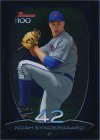 |
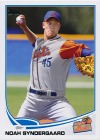 |
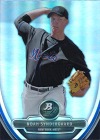 |
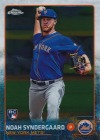 |
| First Mets Card | First Base Mets Card | First Base MLB Mets Card | First Rookie Card |
Like Travis d’Arnaud, Noah Syndergaard had his first Mets cards as inserts in 2013 Bowman, his first base cards with the Mets organization in 2013 Topps Pro Debut, and his first MLB-licensed Mets base cards in 2013 Bowman Platinum. What Syndergaard didn’t get in 2013 (or 2014) was a major league call-up. With an MLB debut in May of 2015, Syndergaard was primed for a big late-season Rookie Card run. Then again, so was Jacob deGrom, and we saw how that turned out. In cardboard though, Syndergaard resembled Zack Wheeler more than deGrom and made his Rookie Card debut with a short print in 2015 Topps Chrome.
Kevin Plawecki
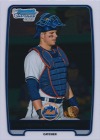 |
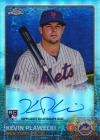 |
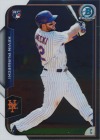 |
| First Pro Card | First Rookie Card | First Base RC |
Kevin Plawecki’s first professional cards came in the usual way, in 2012 Bowman Draft Picks & Prospects. His first Rookie Cards though came three years later in 2015 Topps Chrome. Unlike Noah Syndergaard, Plawecki only had autographs and no base cards. His first base Rookie Cards wouldn’t come until the next Topps product, 2015 Bowman Chrome.
Steven Matz
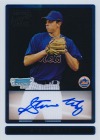 |
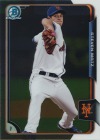 |
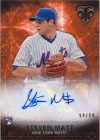 |
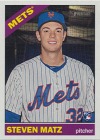 |
| First Pro Card | First Base MLB Card | First Rookie Card | First Base RC |
Every 2015 rookie seemed to take a different path to his first Rookie Card and Steven Matz is no different. In that he is different. You know what I mean… Matz started off his pro career with an autograph card in 2009 Bowman Draft Picks & Prospects. This was back when autographs were part of the base set, so he has no non-autographed version. Over the next five years, Matz would only have unlicensed (2009 Donruss EEE and 2010 Tristar), minor league (2014 Topps Pro Debut), and insert (2014 Bowman Draft) cards. It wasn’t until 2015 Bowman that he got his first MLB-licensed non-autographed base card. And then he got just another insert in 2015 Bowman Chrome before getting his first Rookie Card in 2015 Topps Triple Threads. With an autograph card… His first base Rookie Card wouldn’t come until 2015 Topps Heritage High Number, nearly six years after the journey began.
Michael Conforto
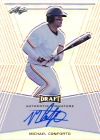 |
 |
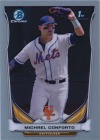 |
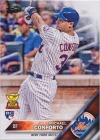 |
| First Pro Card | First Non-auto Card | First MLB Card | First Rookie Card |
Michael Conforto’s quick rise through the Mets system got him through his firsts in just 15 months. But his start included a lot of waiting. Conforto’s first pro card was released about four months after he signed with the Mets – an autograph in 2014 Leaf Metal Draft. Two weeks later, 2014 Panini Perennial Draft Picks had his first non-autographed pro card (an insert) as well as some redemptions for autographs. As of May 2021, those redemptions have yet to be fulfilled. Topps would finally join in another month after that with Conforto’s first MLB-licensed cards in 2014 Bowman Draft. Oddly, there was no autographed version. At least, not until they showed up in 2015 Bowman Chrome… Even though his late July debut in 2015 should have given Topps enough time to make Conforto’s first Rookie Cards later that year, they chose to hold him (and several other big names) back for their 2016 products.
Matt Reynolds
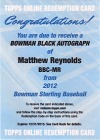 |
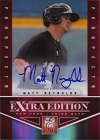 |
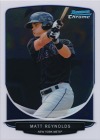 |
| First, um, something? | First Pro Card | First MLB Card |
Matt Reynolds is one example of the complexity with “first” cards these days. While he’s still waiting for his MLB debut and his first Rookie Card, he has made several appearances in cardboard over the last two years and has what may be the oddest debut card of any player in baseball history. As 2012 drew to a close, Topps finished its 2012 product year with the underwhelming 2012 Bowman Sterling, which featured autographs from 2012 Rookie Kirk Nieuwenhuis and 2012 draft picks Gavin Cecchini and Kevin Plawecki. Also on the checklist was the Mets’ third pick in 2012, Matt Reynolds, with a Bowman Black autograph. Introduced earlier in the year, Bowman Black is a multi-year running autograph set featuring silver autographs on thick black cards and serial numbered to just 25 copies. This would have been Reynolds’s first professional card, except for one small problem – a redemption card was issued in its place and the actual card is in cardboard limbo.
Panini brought us the first cards featuring Matt Reynolds a month later in 2012 Panini Elite Extra Edition (yes, released in 2013…). These also featured Reynolds’s first autograph cards, shown above because I don’t have the base version. A few months later, Reynolds would have his first MLB-licensed cards in 2013 Bowman Chrome, which also featured autographed versions (signed now as “M Reynolds”). Also found in 2013 Bowman Chrome is a Matt Reynolds Bowman Black card (dated 2013 on the back, so these can’t just be the 2012 Bowman Sterling cards). The Bowman Sterling redemptions would be fulfilled in 2016, nearly four years after the redemptions were issued. The cards were dated 2012 and signed “Matt Reynolds,” so I don’t know if they were lost in the back of a warehouse for years or fell through a crack in time or what.
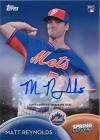 |
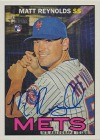 |
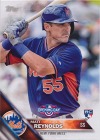 |
| First Rookie Card | First RC in Packs | First Base RC |
If you thought that Reynolds’s Rookie Cards would come in a normal way, you obviously haven’t been paying attention. Reynolds very nearly made his debut in the World Series, but, like his 2012 Bowman Sterling Bowman Black autograph, it amounted to nothing. Still, just being on the postseason roster seems to have made him eligible for Rookie Cards, adding a new wrinkle to the mystery of the MLBPA’s rules for Rookie Card eligibility. His first RCs were Spring Fever autographs distributed in plain foil packs at hobby shops in exchange for cards given out for purchases of 2016 Topps Series 1. Do those even count? I would guess not, but they have the RC logo, so… His first RCs in actual packs intended for sale were also autographs, this time in 2016 Topps Heritage. The next Topps product on the calendar, 2016 Topps Opening Day, had the first base Matt Reynolds RCs, bringing this story to an end. Reynolds, however, is still waiting for his first appearance in an MLB game; in the ultimate irony, he did not make the 2016 Opening Day roster, fittingly announced on April Fools’ Day.
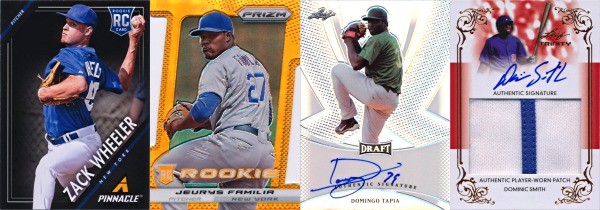
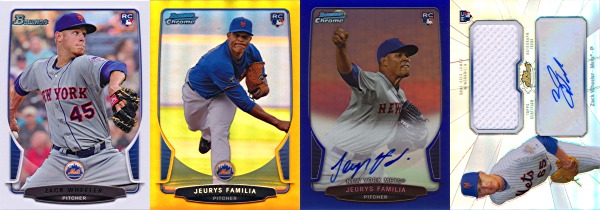
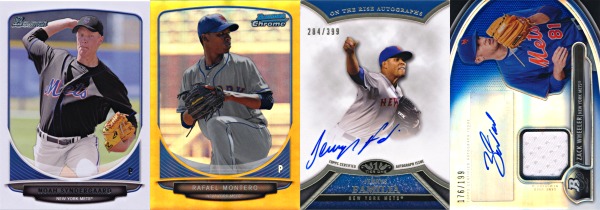
Leave a Comment